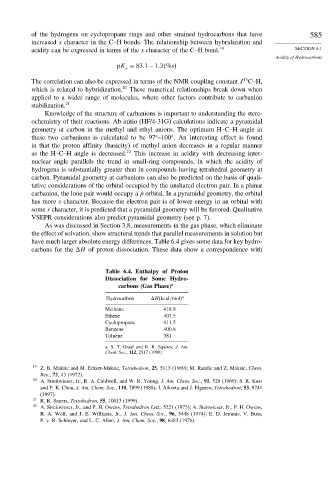Page 603 - Advanced Organic Chemistry Part A - Structure and Mechanisms, 5th ed (2007) - Carey _ Sundberg
P. 603
of the hydrogens on cyclopropane rings and other strained hydrocarbons that have 585
increased s character in the C–H bonds. The relationship between hybridization and
acidity can be expressed in terms of the s character of the C–H bond. 19 SECTION 6.1
Acidity of Hydrocarbons
pK = 83 1−1 3 %s
a
13
The correlation can also be expressed in terms of the NMR coupling constant J C–H,
which is related to hybridization. 20 These numerical relationships break down when
applied to a wider range of molecules, where other factors contribute to carbanion
stabilization. 21
Knowledge of the structure of carbanions is important to understanding the stere-
ochemistry of their reactions. Ab initio (HF/4-31G) calculations indicate a pyramidal
geometry at carbon in the methyl and ethyl anions. The optimum H–C–H angle in
these two carbanions is calculated to be 97 –100 . An interesting effect is found
in that the proton affinity (basicity) of methyl anion decreases in a regular manner
as the H–C–H angle is decreased. 22 This increase in acidity with decreasing inter-
nuclear angle parallels the trend in small-ring compounds, in which the acidity of
hydrogens is substantially greater than in compounds having tetrahedral geometry at
carbon. Pyramidal geometry at carbanions can also be predicted on the basis of quali-
tative considerations of the orbital occupied by the unshared electron pair. In a planar
carbanion, the lone pair would occupy a p orbital. In a pyramidal geometry, the orbital
has more s character. Because the electron pair is of lower energy in an orbital with
some s character, it is predicted that a pyramidal geometry will be favored. Qualitative
VSEPR considerations also predict pyramidal geometry (see p. 7).
As was discussed in Section 3.8, measurements in the gas phase, which eliminate
the effect of solvation, show structural trends that parallel measurements in solution but
have much larger absolute energy differences. Table 6.4 gives some data for key hydro-
carbons for the H of proton dissociation. These data show a correspondence with
Table 6.4. Enthalpy of Proton
Dissociation for Some Hydro-
carbons (Gas Phase) a
Hydrocarbon H kcal/mol a
Methane 418 8
Ethene 407 5
Cyclopropane 411 5
Benzene 400 8
Toluene 381
a. S. T. Graul and R. R. Squires, J. Am.
Chem. Soc., 112, 2517 (1990).
19 Z. B. Maksic and M. Eckert-Maksic, Tetrahedron, 25, 5113 (1969); M. Randic and Z. Maksic, Chem.
Rev., 72, 43 (1972).
20
A. Streitwieser, Jr., R. A. Caldwell, and W. R. Young, J. Am. Chem. Soc., 91, 529 (1969); S. R. Kass
and P. K. Chou, J. Am. Chem. Soc., 110, 7899 (1988); I. Alkorta and J. Elguero, Tetrahedron, 53, 9741
(1997).
21 R. R. Sauers, Tetrahedron, 55, 10013 (1999).
22
A. Streitwieser, Jr., and P. H. Owens, Tetrahedron Lett., 5221 (1973); A. Steitwieser, Jr., P. H. Owens,
R. A. Wolf, and J. E. Williams, Jr., J. Am. Chem. Soc., 96, 5448 (1974); E. D. Jemmis, V. Buss,
P. v. R. Schleyer, and L. C. Allen, J. Am. Chem. Soc., 98, 6483 (1976).

